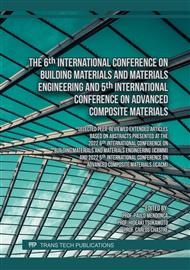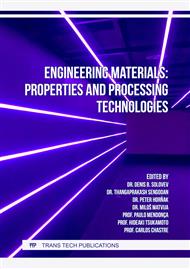[1]
G. Mittal, Sustainable Architecture in Terms of Building Materials. Mat Journals, 1-7. (2017)
Google Scholar
[2]
J.S.N. Duarte. Designing Shelters for 3D-printing. eCAADe, 31-38. (2018)
Google Scholar
[3]
G. Bertino. Fundamentals of Building Deconstruction as a Circular Economy Strategy for the Reuse of Construction Materials. applied sciences, 939. (2021)
DOI: 10.3390/app11030939
Google Scholar
[4]
L.C. Lancaster, Ed.,"Complex Vault Forms of Brick," in Innovative Vaulting in the Architecture of the Roman Empire: 1st to 4th Centuries CE, Cambridge: Cambridge University Press, p.70–98. (2015)
DOI: 10.1017/cbo9781107444935.005
Google Scholar
[5]
R. Rael. Earth Architecture. Princeton, Architectural Press. (2009)
Google Scholar
[6]
A. Curtha. Multi-objective optimization of 3D printed shell toolpaths IASS. (2021)
Google Scholar
[7]
F. Aymerich, L. Fenu and P. Meloni, Constr Build Mater 27 (1) 66-72. (2012)
Google Scholar
[8]
V. Sharma, H. K. Vinayak and B. M. Marwaha, Constr Build Mater 93 943-949. (2015)
Google Scholar
[9]
L. Miccoli, U. Müller and P. Fontana, Constr Build Mater 61 327-339. (2014)
Google Scholar
[10]
C. Galán-Marín, C. Rivera-Gómez and J. Petric Constr Build Mater 24 (8) 1462-68. (2010)
Google Scholar
[11]
M. Gomaaa, 3D Printing System for Earth-based construction: Case Study of Cob Mohamed. Automation in Construction, 124. (2021)
DOI: 10.1016/j.autcon.2021.103577
Google Scholar
[12]
A. Perrot a, e. D., 3D printing of earth-based materials: Processing aspects. Construction and Building Materials, 670-676. (2018)
DOI: 10.1016/j.conbuildmat.2018.04.017
Google Scholar
[13]
N. de Beus, Natural fibres show outstandingly low CO2 footprint compared to glass and mineral fibres. Retrieved from renewable-carbon: https://renewable-carbon.eu/news/natural-fibres-show-outstandingly-low-co2-footprint-compared-to-glass-and-mineral-fibres/ (2019)
DOI: 10.1533/9781845693152.166
Google Scholar
[14]
Niels de Beus, M. C., Carbon Footprint and Sustainability of Different Natural Fibres for Biocomposites and Insulation Material. Germany: RENEWABLE CARBON PUBLICATIONS. (2019)
Google Scholar
[15]
J. P. Correa, Carbon footprint considerations for biocomposite materials for sustainable products: A review. Journal of Cleaner Production, 785-794. (2019).
DOI: 10.1016/j.jclepro.2018.10.099
Google Scholar
[16]
Jorge Fernandes, M. P. (2019). Life cycle analysis of environmental impacts of earthen materials in the Portuguese context: Rammed earth and compressed earth blocks. Journal of Cleaner Production, 241.
DOI: 10.1016/j.jclepro.2019.118286
Google Scholar
[17]
Matheus Pimentel Tinoco a,*.´. (52). Life cycle assessment (LCA) and environmental sustainability of cementitious materials for 3D concrete printing: A systematic . Journal of Building Engineering, 2022.
DOI: 10.1016/j.jobe.2022.104456
Google Scholar



